Boer War veteran
Reginald Wigmore Gaby is my first cousin, three times removed. Our common ancestors are Robert Whiteway, a convicted thief who was transported to Van Diemen’s Land in 1822, and Ellen Wigmore, the eldest daughter of the Reverend Thomas Wigmore, an Irish born clergyman who served in Bothwell in the 1840s before quarrelling with the first Bishop of Tasmania and returning to England.
Reginald’s story is of particular interest because he is one of the very few members of my extended family who, at least as far as I’ve discovered to date, served in the South African (Boer) War. Fought between the United Kingdom and the South African Transvaal Republic and Orange Free State, the war was fought between 11 October 1899 and 31 May 1902. British efforts were bolstered by troops from across the British Empire, including from South Africa, Canada, British India, New Zealand and the Australian colonies. The war ended with the annexation of both the Transvaal Republic and the Orange Free State.
Unfortunately records of the Boer War are sparse and I have not discovered a great deal about Reg’s participation but it is clear from his later life that he exhibited energy, resilience and determination. No doubt these characteristics, together with the bush skills practiced in his youth, helped him to survive the rigours of war in a hostile climate.
Early life
Reginald Wigmore Gaby was born on 19 February 1876, at Tea Tree, to Alfred Athelstone Gaby and Adelaide (nee Whiteway). Today Tea Tree is a five-minute drive north west of Richmond and only 20 minutes north of Hobart; although the road from the capital no doubt took considerably longer to travel back in the 1870s. Located in Tasmania’s Coal River Valley wine region, Alfred Gaby’s 620 acres of farm land may well have given way to picturesque vineyards in the last twenty years or so. In any event, some time during Reginald’s youth, the family moved from the Coal River to Launceston for a short time before moving to a new property near Scottsdale in the state’s north-east.
Reg was the eldest of nine children. Over the first eighteen years of his life seven brothers and one sister were to join the household: Ernest, Emily, Louis, Frank, Charles, Thomas, Alfred and Percy. Sadly, Louis was to die in hospital, from Diphtheria, in 1886, just a few months after his fourth birthday. And the boys were to lose their only sister two years later when nine year old Emily died from ‘typhoid fever’.
Joining up
When he was twenty-three years old, Reg volunteered to join the First Tasmanian Contingent to support the Empire in its fight against the Boers in South Africa. Reg was single and worked as a miner at Scottsdale. He would also have worked on the family’s property, clearing bush and tending to the farm.
He was one of 49 men chosen from the volunteers in the north of the state to join the first contingent. On 19 October 1899 they travelled by express train to Hobart where they joined the southern recruits to form a small contingent totalling 80 men. Met by hundreds of well-wishers at the station, the following day’s news reported that:
Most of them are from outlying parts of the North, and the appearance of the whole body denoted the care that had been exercised in selecting them. Without exception they were a fine, capable looking company …’.[1]
Subsequent articles reported that the men were undergoing more than six hours drilling each day, with a great deal of attention devoted to instructing the men in the use of rifles and bayonet.[2][3] Following a number of enthusiastic farewell receptions, the troops left Hobart en route to South Africa on 27 October, travelling firstly by train to Launceston allowing the northerners further farewells.[4]
Reg became ill and retuned to Australia with 110 invalided Australian soldiers, on board the Karamea, reaching Hobart on 23 July 1900.
Reginald was heartily welcome home by the people of Scottsdale. The Examiner reports his homecoming, on 6 August:
The return of our warrior bold, Trooper R W Gaby, was witnessed last night by upwards of 250 or 300 people. The reception accorded our hero took him quite by surprise, so much so that he retreated to the far end of his carriage when he saw the crowd on the platform; but he soon overcame his timidity and faced the inevitable, and went through his part of the programme like a soldier, with his head up and eyes front. He received a right hearty, warm and cordial reception, and was informed that a public social would be accorded him next Monday night at the Mechanics, for which he was told to be prepared, when we trust the weather will be favourable and the attendance large, befitting the occasion.[5]
Indeed, notwithstanding the inclement weather, more than 110 people attended the social the following week. Mr Ed Button, presented an address, offering:
… sincere and hearty congratulations on the trooper’s safe return home from the seat of war in South Africa. Though deeply regretting that sickness had compelled him to return at this present stage, they were proud to know that while on active service he had nobly done his part in upholding the dignity and honour of this portion of her most gracious Majesty’s dominions.[6]
Once recovered, Reginald joined the 8th Battalion Australian Commonwealth Horse for service in South Africa. Signing up on 21 April 1902, Reg’s papers tell us that he was just a quarter of an inch shy of six feet tall, with a fair complexion, light brown hair and hazel eyes. Aged 26 at the time, Reg was single, living at Scottsdale, listed his occupation as miner and had served as a Private in the First Tasmanian Contingent.
While it is not clear when he was promoted, Reg served as a sergeant in his brief second tour of duty, departing on 21 May 1902 aboard the St Andrew and serving until 28 July. The Mercury of 21 May reported:
The Tasmanian troops (C Squadron), of the Commonwealth Contingent, will embark on the troopship Saint Andrew this (Wednesday) morning. At 8:30 am the squadron, consisting of 116 men and 5 officers, will leave the camp at New Town. It is expected that half an hour will be occupied in the march from the camp to the wharf, the squadron arriving at the ship’s side at 9 am. The soldiery and equipment will be at once taken on board, and after being stored, the horses, 121 in number, will be embarked. It is expected that the horses will be baled up in their respective stalls, and by 10:30 am this work should be finished, and the men ready to store their baggage on board, which will be at the ship’s side at that hour.
All work in connection with the embarkation will, probably, be finished by 11 am, at which hour the men of the squadron will be allowed to come on shore and spend three-quarters of an hour in bidding farewell to their friends. … It is expected that the vessel will leave the wharf at noon.
The men of the departing contingent have attained quite as high a state of efficiency as the troops that previously left Tasmania, and despite the continuous drain upon the horses of the State, are as well mounted.[7]
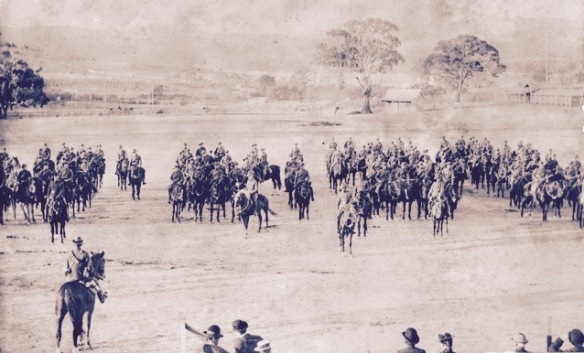
Parade of C Squadron of the 8th Battalion Australian Commonwealth Horse (Australian War Memorial) (edited)
Interestingly, while there were dozens of articles welcoming Gaby home from his first tour of duty, it is much harder to follow his return journey. Perhaps the press was already growing tired of this war that had gone on for longer than originally anticipated. The Australian troops were integrated with British regiments and took no distinctive part in the major battles. Somewhat embarrassingly, the colonial troops lost slight more men to disease than to enemy action.[8] Of the 16 000 Australians engaged, 282 died in action or from wounds, while 286 died from disease, particularly typhoid or ‘enteric fever’ as it was commonly known.[9]
Indeed, the next reference I can find to Reg is his inclusion in a list of those ‘Sick in hospital in South Africa’ during the last days of his deployment.[10] His service was recognised by the award of the Queen’s South Africa Medal with clasps for Cape Colony and Orange Free State.
Reg’s daughter Marie Jean and grandson Neville record that Reg was a man of strong character and pride. His four younger brothers served in World War I and his own four sons served in World War II. They say he was motivated by a desire to serve his country and to earn money towards a farm of his own.
After the Boer War, Reg moved to Tasmania’s north-west, where he selected and cleared bush land at Nabageena, twenty kilometres south of Smithton. He established a dairy farm that was to remain in the family for the next century.
In 1907 Reg married Mary Bald at Jetsonville, near Scottsdale. The couple was to have four boys and five girls.
An article in the Circular Head Chronicle tells us more[11]:
The thought that lead to the pioneering of Nabageena, first settlement among the fertile hills lying south of Irishtown, were born on a Boer War battlefield. It was there that Reg W Gaby, a young Tasmanian from the North-east Coast, first heard of the possibilities of Sunny Hills, as the district was then known, and decided to run an eye over it when he returned to his homeland.
It must have been a determined and energetic eye for, a fortnight after he had returned from South Africa, Mr Gaby was exploring the forest of gum and blackwood which, from his east-coast experience, prejudiced him in favour of the area. A few days later, having applied for 150 acres, he was in Hobart asking and obtaining permission to begin clearing on 25 acres before the survey was made.
His was not the first axe to ring in the Nabageena hills, for J Laird, a Victorian, who subsequently returned to that State, had selected 320 acres and cleared and grassed much of it several years earlier. This had reverted to second growth before Mr Gaby’s arrival. …
… Mr Gaby’s first building was the inevitable bush hut, but such care was used in axe-dressing the timber that one of the first visitors thought it had been sawn, and asked how it had been conveyed in the absence of a road.
Another old timer who frequently camped at the hut complained bitterly because the timber was so smoothly dressed that he could never find a splinter with which to pick his teeth.
… But enthusiasm can do much and, acting for friends and acquaintances from the east coast, Mr Gaby explored and reported on the country as far back as the Trowutta hills and down into the Duck River valley, with the result that over 1000 acres were selected.
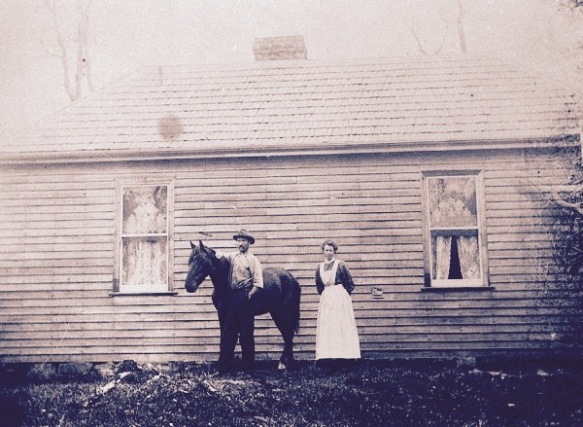
Mr & Mrs R W Gaby’s home at Nabageena, 1909. The home was built using split timber weatherboards and a shingle roof. (Courtesy eHeritage, Circular Head Heritage Centre)
In 1916, in an article on the Potato Industry, the Circular Head Chronicle cites Mr F W Ulbrich, the ‘potato expert of the Agriculture Department’ giving advice to farmers about dealing with ‘Irish blight’ and refers to Reg’s practices with approval[12]:
Mr Ulbrich said he might mention that Mr Reg Gaby of Sunny Hills had sent along to him at Devonport last season for exhibition purposes samples of Red Bismarks, Gem of the South, and ordinary Reds. They were the result of careful culling of seed, using tubers only true to type.
Reg was also active in the local dairy industry. In 1927 a report of the Annual Shareholders meeting at Smithton has Reg Gaby ‘strenuously advocating’ amalgamation of local butter factories; a motion that was carried at the same meeting.[13]:
Mr Reg Gaby strenuously advocated amalgamation. He said that the industry needed some impetus as there was a steady retrograde tendency. Amalgamation was calculated to benefit the suppliers and to relieve them of much of the drudgery which at present fell to their lot. It would also cut down running expenses. It seemed ridiculous that on the North-west Coast there were many butter factory lorries competing against one another on the same roads. That alone showed the urgent need for amalgamation. Obsolete methods should be discarded at the first opportunity. The question affected all branches of agricultural and pastoral life. The speaker had been to coastal factory meetings, and had learned there that the scheme now being considered along the coast was peculiarly suited to the local factory. Suppliers should have a bigger say, and then the feeling of the people could be accurately gauged.
The Advocate published a story on the growth of the Nabageena District in 1932 which reveals a little more of Reg’s pioneering and farming efforts[14]:
Mr R W Gaby’s property of 185 acres has always been regarded as one of the best in this fast-progressing district, being especially good for the growth of grass, while for agriculture the lower lands are equally productive. Mr Gaby, who is a veteran of the Boer War, in which he enjoyed the distinction of being the youngest trooper-sergeant on active service, has been at Nabageena for the past 30 years, at which time the present fine country was all virgin forest, with the exception of a few blocks which had been scrubbed and grassed but then left to grow up again with undergrowth. There was much heavy timber to contend with when this Nabageena pioneer started including eucalypts, sassafras, blackwood, dogwood, musk and man fern, flora always indicative of rich soil well worth bringing into a state fit for cultivation or dairying. I noticed Mr Gaby hard at work on a rich alluvial flat of about 10 acres, which next year should give a good return, being well drained and rich in appearance. In grasses, cocksfoot, English, White Dutch and alskye are preferred, with some good subterraneum on the high ground and a little elsewhere.
Top-dressing is found to pay handsomely when one bag of super per acre is used, about 80 acres per year being treated. In Mr Gaby’s opinion the direct benefit derived from this enriching of the soil admits of no doubt or argument the increased quantity of milk and improved appearance of stock proving this very conclusively. Here some 50 cows are milked, the fine herd consisting of some pure bred Jerseys, but Jersey grade cows predominating. Only heifer calves are reared. For the past ten years only registered Jersey bulls have been used, these coming from the famous herd of Mr B T Saddler, East Devonport. A “New Zealandia” milking machine is installed and for 10 years this plant has given every satisfaction.
I noticed a good concrete floor in the milking shed, which is up-to-date in every way, the cowyard also being well graveled and paved with stones. Water is laid on to the shed, and this and another property of 150 acres are specially well off in the matter of permanent water. Hedges of macrocarpas surround the comfortable homestead, which in the “old days” was regarded as the customary house of call for all and sundry whose business or pleasure called them to the new settlement of Nabageena.
In another article a few month’s later, reporting on the ‘magnificent country’ of Smithton’s hinterland, the Advocate reported:[15]
Mr R W Gaby, of Nabageena, claims to be the pioneer of that area. He took up land there 30 years ago on his return from the South African war. He had bush experience on the North-East, and turned it to good account in the Far North West. He affirms that the Nabageena country is better than any of the old settled lands. He puts it value down at £20 per acre. Another district settler placed a similar value on cleared farms.
… Nabageena is myrtle country, which lends itself to clearing, as the Yolla experience testifies, hence, after the lapse of 30 years, the district has quite a settled appearance, with many good metal roads and others which will call for metalling when the country’s finances improve.
… Dairying is the chief pursuit, and some large herds are being milked. Mr Gaby has 45 cows; others have more. On one farm 75 cows are milked.
In 1952 and 1954, Reg travelled to Boer War reunions in Kalgoorlie and Hobart, remarking that at that time only 100 of the 850 Tasmanians who had served in the Boer Ware were still living.[16]
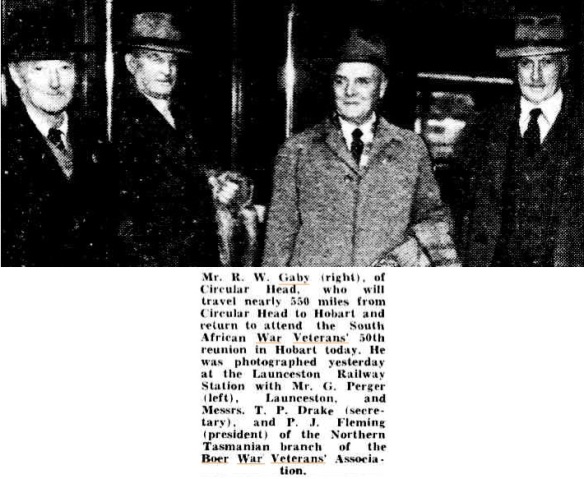
South African War Veterans 50th Reunion, The Mercury (Hobart, Tas. : 1860 – 1954), 31 May, p. 3, http://nla.gov.au/nla.news-article27091430

1954 ‘BOER WAR VETERANS.’, Advocate (Burnie, Tas. : 1890 – 1954), 13 November, p. 3 http://nla.gov.au/nla.news-article69867896
Four years later, Reg travelled to London, where he represented his younger brother, Alfred Edward Gaby VC at the Victoria Cross Centenary Review of Holders of the Decoration by Her Majesty Queen Elizabeth II, Hyde Park, on 26 June 1956. This occasion warranted a colour spread in the Australian Women’s Weekly, and Reg was photographed with a French artist from a West End hit show at the Lyceum Theatre Party.[17] A far cry from Nabageena!
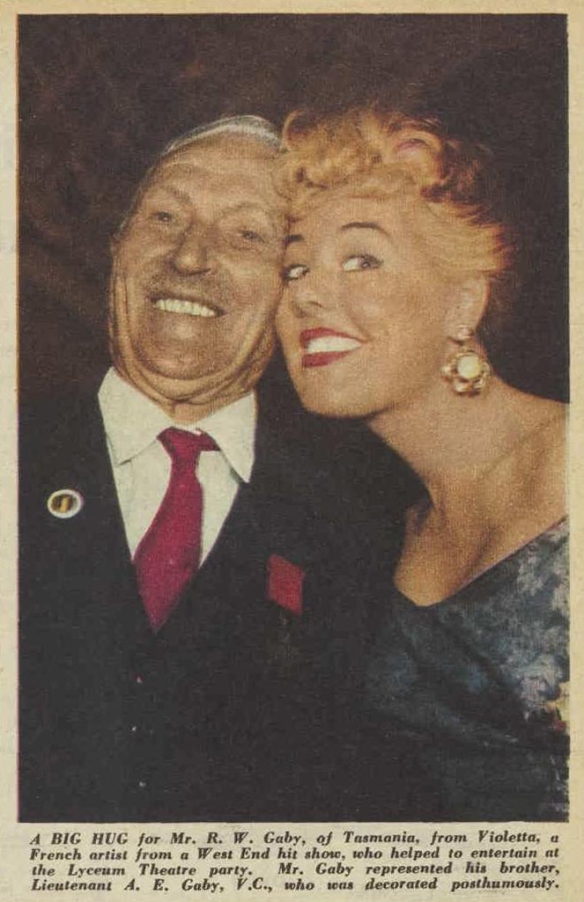
1956 ‘AUSTRALIAN V.C.s “OFF PARADE”.’, The Australian Women’s Weekly (1933 – 1982), 1 August, p. 16, http://nla.gov.au/nla.news-article51775295
When Mary Gaby died in May 1952, the Advocate reported:
Mrs Mary Gaby, a highly esteemed resident of Circular Head, died at her home, after a long illness, on May 12. She went to the district from Jetsonville, near Scottsdale, as a bride just after the turn of the century with her husband Reginald W Gaby. It was her first journey into the far North West to her home “Mary Banks”, Nabageena, previously selected by her husband. Surrounded by bushlands and far removed from neighbours, the late Mrs Gaby, sustained by a virile Christian faith, won the respect of all.[18]
Reginald Wigmore Gaby died on 5 August 1971. He was 95 years old.
[1] 1899 ‘AUSTRALIAN CONTINGENT.’, The Mercury (Hobart, Tas. : 1860 – 1954), 20 October, p. 3, viewed 7 June, 2015, http://nla.gov.au/nla.news-article12760394
[2] 1899 ‘AUSTRALIAN CONTINGENT.’, The Mercury (Hobart, Tas. : 1860 – 1954), 23 October, p. 3, viewed 7 June, 2015, http://nla.gov.au/nla.news-article12760865
[3] 1899 ‘AUSTRALIAN CONTINGENT.’, The Mercury (Hobart, Tas. : 1860 – 1954), 24 October, p. 3, viewed 7 June, 2015, http://nla.gov.au/nla.news-article12761120
[4] 1899 ‘AUSTRALIAN CONTINGENT FOR SOUTH AFRICA.’, The Mercury (Hobart, Tas. : 1860 – 1954), 27 October, p. 3, viewed 7 June, 2015, http://nla.gov.au/nla.news-article12761744
[5] 1900 ‘COUNTRY NEWS.’, Examiner (Launceston, Tas. : 1900 – 1954), 9 August, p. 2 Edition: DAILY, viewed 7 June, 2015, http://nla.gov.au/nla.news-article35366464
[6] 1900 ‘RETURN OF TROOPER GABY.’, Examiner (Launceston, Tas. : 1900 – 1954), 16 August, p. 6 Edition: DAILY, viewed 7 June, 2015, http://nla.gov.au/nla.news-article35367450
[7] 1902 ‘COMMONWEALTH CONTINGENT.’, The Mercury (Hobart, Tas. : 1860 – 1954), 21 May, p. 3, viewed 7 June, 2015, http://nla.gov.au/nla.news-article9582689
[8] Jim Davidson, ‘The Boer War’ in Griffith Review 48: Enduring Legacies, Brisbane: 2015, p26
[9] Thomas Keneally, Australians: Eureaka to the Diggers, Melbourne: Allen & Unwin, 2011, pp 221-225
[10] 1902 ‘TASMANIANS IN SOUTH AFRICA.’, Daily Telegraph (Launceston, Tas. : 1883 – 1928), 4 August, p. 2, viewed 8 June, 2015, http://nla.gov.au/nla.news-article153821394
[11] 1954 ‘Nabageena — first of district’s southern settlements.’, Circular Head Chronicle (Stanley, Tas. : 1906 – 1954), 17 November, p. 11, viewed 8 June, 2015, http://nla.gov.au/nla.news-article163476968
[12] 1916 ‘The Potato Industry.’, Circular Head Chronicle (Stanley, Tas. : 1906 – 1954), 5 January, p. 2, viewed 8 June, 2015, http://nla.gov.au/nla.news-article160995841
[13] 1927 ‘BUTTER FACTORY.’, Circular Head Chronicle (Stanley, Tas. : 1906 – 1954), 14 September, p. 3, viewed 8 June, 2015, http://nla.gov.au/nla.news-article169013132
[14] 1932 ‘With Plough and Cow. Nabageena District.’, Advocate (Burnie, Tas. : 1890 – 1954), 30 January, p. 9, viewed 8 June, 2015, http://nla.gov.au/nla.news-article67904909
[15] 1932 ‘FAR NORTH-WEST.’, Advocate (Burnie, Tas. : 1890 – 1954), 27 April, p. 9, viewed 8 June, 2015, http://nla.gov.au/nla.news-article67921830
[16] 1954 ‘BOER WAR VETERANS.’, Advocate (Burnie, Tas. : 1890 – 1954), 13 November, p. 3, viewed 7 June, 2015, http://nla.gov.au/nla.news-article69867896
[17] 1956 ‘AUSTRALIAN V.C.s “OFF PARADE”.’, The Australian Women’s Weekly (1933 – 1982), 1 August, p. 16, viewed 7 June, 2015, http://nla.gov.au/nla.news-article51775295
[18] 1952 ‘Mrs. Mary Gaby.’, Advocate (Burnie, Tas. : 1890 – 1954), 26 May, p. 4, viewed 17 May, 2015, http://nla.gov.au/nla.news-article69461075

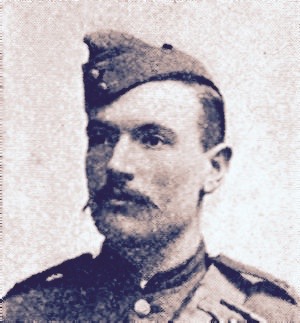

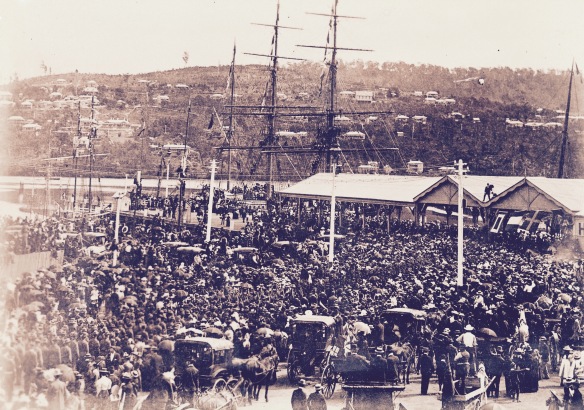
I am delighted to have heard from a Gaby family descendant that Reginald’s brother, Ernest Alfred Gaby, also served in the Boer War. Ernest had travelled to New Zealand for work and signed up in Auckland to fight as part of the New Zealand contingent.
Hi Lynne, I am not a direct descendant, but share ancestors (Ernest and Reginald and siblings are 5th cousins 3 times removed), I just wanted to thank you for sharing your research and family information (I have just discovered part of the family went to Tasmania, my branch headed to New Zealand)
Kind regards
Donna
Thank you Donna – appreciate you taking the time to comment, regards, Lynne